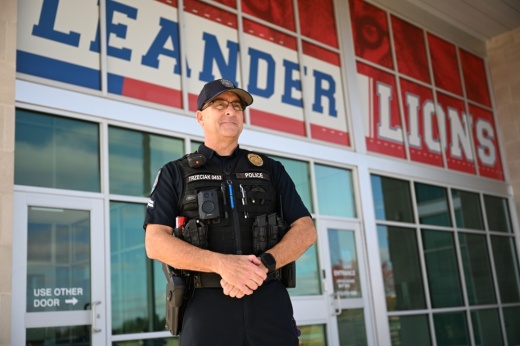House Bill 3, passed in 2023, mandated districts to staff an armed security guard on every campus by Sept. 1. However, Leander ISD claimed a good-cause exception, which provides districts more time and options to satisfy the law.
District officials said creating an in-house police department is the best path forward, but they anticipate facing challenges along the way due to a lack of funding and competition in hiring.
The overview
Leander ISD officials are in the initial stages of building a district police force after the board of trustees approved the department’s creation and first round of funding Nov. 30.
The district amended this fiscal year’s budget by $1.1 million to hire some staff and cover costs for training, insurance, and equipment. With a plan to hire 67 total officers, the entire department is expected to take multiple years and millions of dollars to create, officials said.
HB 3 author Rep. Dustin Burrows, R-Lubbock, said the bill’s armed officer requirement aims to increase school security and “reduce confusion in the midst of a crisis,” such as an active shooter situation.
With over 42,000 students across 48 campuses, LISD has struggled to comply with the law. District officials said the state has not provided enough funding to implement HB 3.
The approach
Building its own police department will give LISD the greatest control over how it hires and trains armed officers, said Bryan Miller, executive director of student support.
Staffing more school resource officers from local police departments—the method the district currently uses to have officers at its high school campuses and Leander Middle School—was not an option as those agencies are short staffed, he said.
Representatives with Travis County Sheriff’s Office, Cedar Park Police Department and Leander Police Department confirmed they are experiencing officer shortages.
“Very quickly, [we realized] there was no way they could create that kind of capacity through our partnership, so we had to explore other avenues,” Superintendent Bruce Gearing said.
The district will assign school marshals to elementary campuses as they have less authority than commissioned peace officers but still hold a license to carry, Miller said. Unlike police officers, school marshals will be able to contribute to administrative work, such as emergency response protocols or monitoring recess, he said.
LISD parent Brad Ferguson said he is concerned about young students being disciplined by armed guards instead of educators.
Neither officers nor school marshals will be the first to respond to school discipline concerns but may play a supportive role through talking with students or reminding them to follow campus rules, Miller said. The district’s disciplinary response will be guided by its code of conduct while police officers will address criminal ramifications, he said.
Police officers and school marshals will report to a chief of police while the chief will report to the superintendent in accordance with state law.
Both school marshals and officers will receive training on child development and interacting with students while marshals will partake in professional training and learning along with teachers, he said.
The speed at which the department is developed largely depends on the district’s ability to hire and train applicants, Miller said.
“You’ve got 1,200-plus districts competing for licensed police officers to join departments and have the correct training, along with marshals,” Miller said.
Officer responsibilities
Police officers
- Primary role to address criminal activity
- 1,400 hours or eight to nine months of training, including the School-Based Law Enforcement Officer Proficiency Certificate
- Commissioned peace officer with full arrest and investigation powers
- Cannot be assigned to address administrative tasks or disciplinary issues
- Primary role to respond to an active threat
- 80 hours of training and psychological exam
- Arrests only to prevent imminent bodily harm
- May complete administrative safety and security tasks, including developing response protocols, hosting trainings and conducting door audits
In fiscal year 2023-24, the district transferred $1.1 million out of its fund balance to begin the police department, Gearing said.
While HB 3 allocates districts $10 per student and $15,000 per campus to meet its requirements, the $1.1 million from the bill in state funding has already been allocated for the district’s existing school resource officers, Miller said.
School board President Gloria Gonzales-Dholakia said there’s nowhere in the district’s budget to cut expenses as the majority goes to staff salaries.
“If the state does not kick in additional funding, then we’re going to have to make some very difficult choices about what we stop doing in order to make this mandate happen,” Gearing said.
However, some members of the community have expressed concerns that the district should have chosen a less costly option to arm its campuses, such as arming teachers through a school guardian program.
In their own words
“It’s going to be our job to make sure ... the presence of those officers is really comforting as opposed to intimidating," Gearing said.
“I think with smaller classrooms and more school counselors, we’d be able to do more on our campuses with school safety, but that’s not one of our choices," Gonzales-Dholakia said.
Looking forward
District officials are now working on an application to create the department with the Texas Commission on Law Enforcement. As a part of that process, the district will need to name a police chief, hire an administrative assistant and adopt a board policy outlining how the department will be structured, Miller said.
Officials are hoping to have the application submitted in the spring and receive approval in the summer. Once approved, the district can officially hire police officers with the goal of having some officers and school marshals on campuses by fall.
LISD will continue its school resource officer partnerships with local police departments until those officers are no longer needed, Miller said.
“While there is a potential cheaper option out there, sometimes you get what you pay for,” Miller said. “We want to be sure that we are providing the ... best people for our campuses.”
Implementation timeline
The district hopes to have next steps completed by the following tentative dates, Miller said.
- Late January: Name police chief and adopt board policy
- Spring: Submit TCOLE application
- Summer: Receive TCOLE decision
- August: Assuming TCOLE approval, assign officers/school marshals to some campuses





